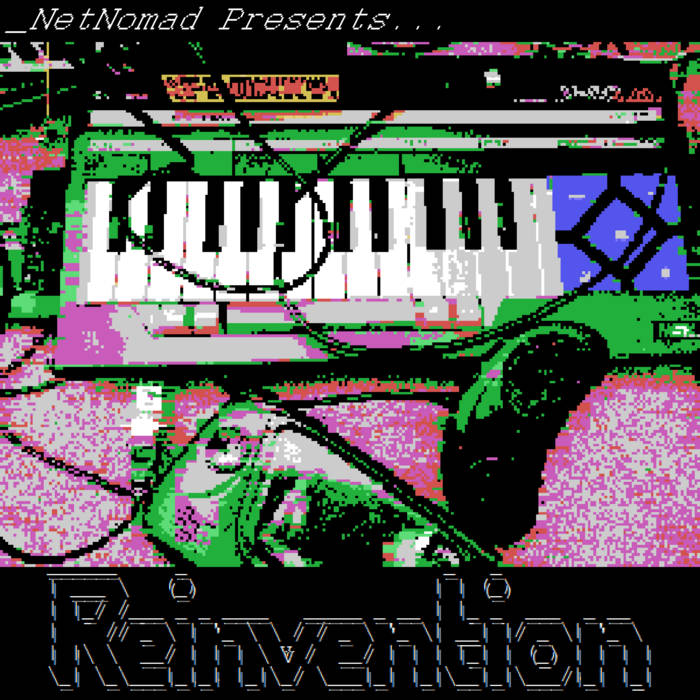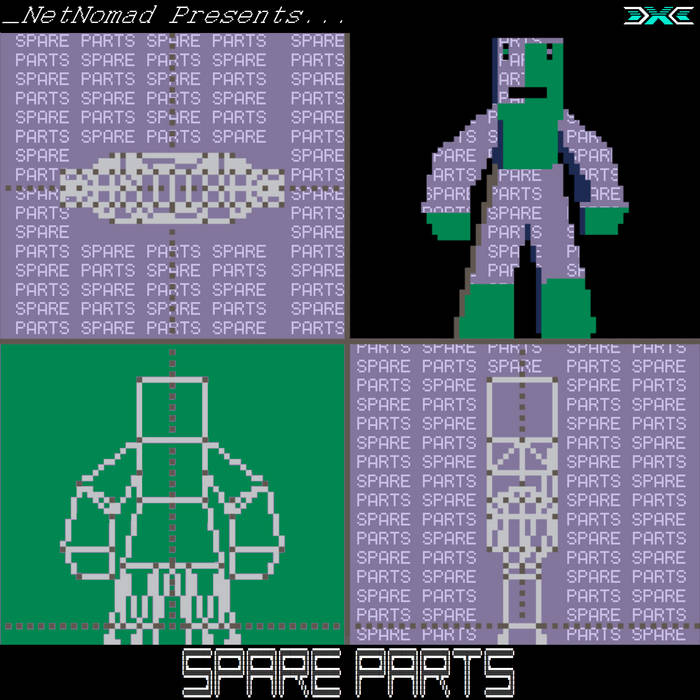

The first _NetNomad release, almost a year to the day from when I started writing chiptune. The opening song actually predates that, being an assignment from high school music theory. These were all made in Shiru's VGMMaker, the original OPN2+DCSG tracker. The cover is actually a modified snapshot of what that tracker looks like opened in Notepad! Both from a writing and sound-design standpoint, this entire EP is a bit like flailing around in the dark, but in spite of that I think some of these hold up, with Safe Haven in particular still being a favorite of mine. There were also definitely a few stinkers, especially the two covers from the original Soundcloud version that didn't make the jump to Bandcamp because I didn't know how to license them back then. I wanted to do actual hardware recordings for the release, but I didn't realize until it was too late that VGMM is 50hz by default- you live and you learn!

This was an anthology release I put together when I finally made my Bandcamp account, of everything from my Soundcloud I thought was worth taking over. Songs from the Soundcloud, get it? This captures the remainder of my work in VGMM, while also being my earliest attempt to branch out into other software and other soundchips. Pine Bush was made in Furious Advance Tracker for the GBA, and Forest Pipes was written specifically for the anthology on Sneventracker, a Famitracker-style DCSG tracker. Given the overlap in their developement time, you could consider this a companion piece to the Network Nomad EP.

This one was my first real LP, written during the last three years of college (which explains it's "vent art" vibe). Most of these songs were written in Adlib Tracker II- recording from a Genesis/Mega Drive was getting frustrating because of the agressive filtering on my Model 2, so I branched out into MS-DOS figuring working with audio directly out of a computer would be easier. The OPL3 despite having way more polyphony is actually a much simpler chip than the Genesis sound hardware, so instead of turning knobs randomly and just stealing voices from games, I started to build a real sense for FM sound design which allowed me to be much more deliberate. If you want to write FM Chiptune but find 4 OP FM synthesis intimidating, spend a month or two in Adlib Tracker ][ and you'll be shocked by what you learn.
The name of the album comes from Full Motion Video, or FMV, commonly used back when prerendered video in a video game was a technical challenge and a real novelty. I was also experementing with video synthesis at the time, so I wanted the entire album to have a video counterpart that could be played back on a SEGA CD or a Saturn or something. That didn't quite pan out, as homebrew tools on both platforms weren't where they are today, but a truncated video EP featuring four of the songs was actually released. My other big goal for the album was for some songs to have vocals, so I learned to play the talkbox. Trying to record everything at an appropriate volume in a dorm or your mom's basement isn't easy, though, so I ended up with recordings that I had to really deep-fry just so they could make it through the mix, making them essentially unintelligable. Maybe that was for the best, though!

Immediately after completing Full Motion, I got to work on another album, originally titled Clock Cycles. That was a name I almost used for Full Motion, and it was an appropriate choice because my goal here was to accomplish the things I tried and failed to do with that album. Shortly after, circumstances changed and a lot of those plans became unfeasible. A global pandemic sure didn't help! Around that same time, though, I had just gotten an MSX and was learning the dark art of MML. New circumstances, new methodology, "new normal"... my second album quickly morphed into something else entirely, hence the name Reinvention.
This is the album where I really feel like I came into myself as a writer. The album is, for lack of a better term, unapologetically me. A lot of influences that were previously burried finally broke through to the forefront, and I finally felt like I was writing what I wanted to write instead of writing whatever I had happened to write. The modular nature of the MSX meant I was able to explore a wider variety of sounds with the same workflow- one of those modules I actually assembled by hand! And only burnt myself, like, three times! The album was also chock full of music from games, as I started doing game jams as well as solo projects, another dream finally falling into place. I had to roll with the punches a bit- a hand injury meant my goal of adding live elements to my music simply wasn't going to happen, but I think that was a fair tradeoff to get what this album became.

Spare Parts is a bit of a companion piece to Reinvention. In many ways, it's its inverse- On Reinvention, all but one songs are "pure" chiptune recorded directly from the chips, whereas all but one of the songs here were done with VSTs. Reinvention partially happened because I couldn't play anything live, whereas Spare Parts features EWI solos on 5 songs as my hands got better. Reinvention had no vocal tunes, but Spare Parts featured my first forays into vocal synthesis. Reinvention was a long-term goal, while Spare Parts was assembled retrospectively out of, well, spare parts! DMV is probably the song that best exemplifies this. I wrote it as a gag when a friend left that voice message featured in the second half, but I accidentally put more effort into it than the usual meme song. Now it's the second tune on the album! In spite of it's rather haphazard nature, I think it's just about as good as Reinvention. Much like how I came into myself as a writer on Reinvention, I feel like I came into myself as a performer here. Music is strange- sometimes you drive it, and sometimes it drives you. Embrace that push and pull and you'll be suprised just where it'll take you.
The above albums form what you might call the main canon of my music, but I've also done a number of collaborations and compilations. A lot of that earlier stuff is linked on my Bandcamp page, and more recent collaborations with the DXC folks can be found on our Faircamp page. Anything you can't find on those two, including most of my covers, can be found on my Youtube channel.